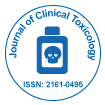Journal of Clinical Toxicology : Citations & Metrics Report
Articles published in Journal of Clinical Toxicology have been cited by esteemed scholars and scientists all around the world. Journal of Clinical Toxicology has got h-index 20, which means every article in Journal of Clinical Toxicology has got 20 average citations.
Following are the list of articles that have cited the articles published in Journal of Clinical Toxicology.
| 2024 | 2023 | 2022 | 2021 | 2020 | 2019 | 2018 | 2017 | 2016 | 2015 | 2014 | 2013 | 2012 | 2011 | |
|---|---|---|---|---|---|---|---|---|---|---|---|---|---|---|
Total published articles |
29 | 31 | 33 | 63 | 34 | 34 | 33 | 33 | 56 | 51 | 47 | 60 | 57 | 17 |
Research, Review articles and Editorials |
12 | 21 | 26 | 64 | 18 | 17 | 24 | 19 | 39 | 25 | 36 | 43 | 46 | 11 |
Research communications, Review communications, Editorial communications, Case reports and Commentary |
13 | 10 | 17 | 34 | 21 | 17 | 9 | 14 | 28 | 24 | 11 | 11 | 16 | 6 |
Conference proceedings |
6 | 0 | 6 | 0 | 0 | 0 | 77 | 51 | 198 | 98 | 83 | 95 | 65 | 0 |
Citations received as per Google Scholar, other indexing platforms and portals |
257 | 331 | 376 | 432 | 400 | 358 | 353 | 269 | 239 | 196 | 79 | 32 | 10 | 0 |
| Journal total citations count | 2911 |
| Journal impact factor | 5.72 |
| Journal 5 years impact factor | 8.04 |
| Journal cite score | 9.78 |
| Journal h-index | 20 |
| Journal h-index since 2019 | 16 |
Important citations (838)
Dose-dependent oxidative damage in erythrocytes and hepatic tissue of wistar rats concurrently exposed with arsenic and quinalphos: a subacute study |
|
Carnosine: a possible drug for vascular dementia |
|
Review on natural excipients in the formulation of oral fast dissolving films |
|
Naringin ameliorates sodium arsenite-induced renal and hepatic toxicity in rats: decisive role of kim-1, caspase-3, tgf-?, and tnf-? |
|
Tetrahydrocurcumin ameliorates free fatty acid-induced hepatic steatosis and improves insulin resistance in hepg2 cells |
|
Ameliorative efficacy of tetrahydrocurcumin against arsenic induced oxidative damage, dyslipidemia and hepatic mitochondrial toxicity in rats |
|
Copper as a collaborative partner of zinc-induced neurotoxicity in the pathogenesis of vascular dementia. |
|
Tetrahydrocurcumin attenuates carbon tetrachloride-induced hepatic fibrogenesis by inhibiting the activation and autophagy of hepatic stellate cells |
|
Counteracting arsenic toxicity: curcumin to the rescue? |
|
Erbb4 cleavage by gonadotropin-releasing hormone receptor stimulation in cultured gonadotroph cells. |
|
Comparative efficacy of syzygium cumini seed extracts in alleviating arsenic-induced hepatotoxicity and blood cell genotoxicity in wistar albino rats |
|
Effect of a controlled food-chain mediated exposure to cadmium and arsenic on oxidative enzymes in the tissues of rats |
|
An appraisal on molecular and biochemical signalling cascades during arsenic-induced hepatotoxicity |
|
Natural antioxidants against arsenic-induced genotoxicity |
|
Drinking water pollutants may affect the immune system: concerns regarding covid-19 health effects |
|
Up-regulation of dusp5 and dusp6 by gonadotropin-releasing hormone in cultured hypothalamic neurons, gt1-7 cells |
|
Maternal exposure to di-2-ethylhexylphthalate and adverse delivery outcomes: a systematic review |
|
Di (2-ethylhexyl) phthalate (dehp)-induced hepatotoxicity in quails (coturnix japonica) via triggering nuclear xenobiotic receptors and modulating cytochrome p450 systems |
|
Relationship of urinary phthalate metabolites with cardiometabolic risk factors and oxidative stress markers in children and adolescents |
|
Fyn-mediated phosphorylation of pyk2 promotes its activation and dissociation downstream of gonadotropin-releasing hormone receptor. |
|
